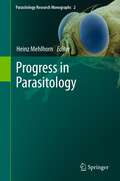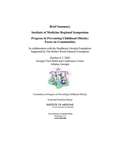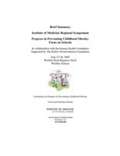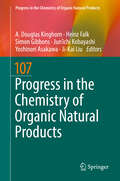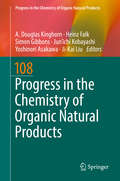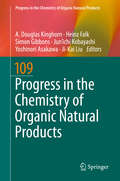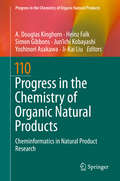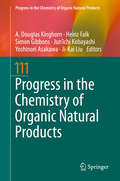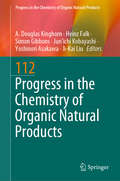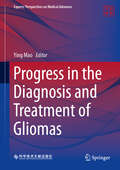- Table View
- List View
Progress in Parasitology
by Heinz MehlhornParasites threaten the health of animals and humans alike. Especially in times of increasing globalization and global warming, parasites can enlarge their "kingdom" by spreading. At the same time many of the existing medical products have become ineffective. As these products have been used for many decades, parasites have developed resistances, so that they have progressed in their fight for survival. Therefore it is obvious that humans must develop new methods to face these dangers. Thus parasitological knowledge increases daily and must be formulated to be accessible for as many parasitologists (veterinarians, physicians, biologists) as possible. Therefore it is necessary that reviews reflecting the present status of the progress in many fields of research be published. Therefore this book, published on the occasion of the 50th anniversary of the German Society of Parasitology, compiles 18 reviews on recent "hot topics," including a new vaccine against malarial parasites; severe diseases with poor chances of treatment (cryptosporidiosis, coccidiosis, theileriosis); vectors (mosquitoes, ticks) and their transmission activities; and fish parasites, including molecular insights into the sex of parasites with a focus on the survival abilities that made them so dangerous. These chapters provide detailed information for researchers, as well as for teachers and students in parasitology.
Progress in Preventing Childhood Obesity: Brief Summary
by Institute of Medicine of the National AcademiesThe National Academies Press (NAP)--publisher for the National Academies--publishes more than 200 books a year offering the most authoritative views, definitive information, and groundbreaking recommendations on a wide range of topics in science, engineering, and health. Our books are unique in that they are authored by the nation's leading experts in every scientific field.
Progress in Preventing Childhood Obesity: Focus on Industry
by Institute of Medicine of the National AcademiesThe National Academies Press (NAP)--publisher for the National Academies--publishes more than 200 books a year offering the most authoritative views, definitive information, and groundbreaking recommendations on a wide range of topics in science, engineering, and health. Our books are unique in that they are authored by the nation's leading experts in every scientific field.
Progress in Preventing Childhood Obesity: Focus on Schools
by Institute of Medicine of the National AcademiesThe National Academies Press (NAP)--publisher for the National Academies--publishes more than 200 books a year offering the most authoritative views, definitive information, and groundbreaking recommendations on a wide range of topics in science, engineering, and health. Our books are unique in that they are authored by the nation's leading experts in every scientific field.
Progress in Preventing Childhood Obesity: How Do We Measure Up?
by Institute of Medicine of the National AcademiesThe remarkable increase in the prevalence of obesity among children and youth in the United States over a relatively short timespan represents one of the defining public health challenges of the 21st century. The country is beginning to recognize childhood obesity as a major public health epidemic that will incur substantial costs to the nation. However, the current level of investment by the public and private sectors still does not match the extent of the problem. There is a substantial underinvestment of resources to adequately address the scope of this obesity crisis. At this early phase in addressing the epidemic, actions have begun on a number of levels to improve the dietary patterns and to increase the physical activity levels of young people. Schools, corporations, youth-related organizations, families, communities, foundations, and government agencies are working to implement a variety of policy changes, new programs, and other interventions. These efforts, however, generally remain fragmented and small in scale. Moreover, the lack of systematic monitoring and evaluation of interventions have hindered the development of an evidence base to identify, apply, and disseminate lessons learned and to support promising efforts to prevent childhood obesity. Progress in Preventing Childhood Obesity: How Do We Measure Up? examines the progress made by obesity prevention initiatives in the United States from 2004 to 2006. This book emphasizes a call to action for key stakeholders and sectors to commit to and demonstrate leadership in childhood obesity prevention, evaluates all policies and programs, monitors their progress, and encourages stakeholders to widely disseminate promising practices. This book will be of interest to federal, state, and local government agencies; educators and schools; public health and health care professionals; private-sector companies and industry trade groups; media; parents; and those involved in implementing community-based programs and consumer advocacy.
Progress in Social Psychiatry in Japan
by Yoshibumi NakaneSocial psychiatry is a multidisciplinary field analyzing mechanisms of mental health issues comprehensively to contribute to society using the findings. Those findings include biological, psychological, and social aspects and they are based on psychiatry and connected with a wide variety of academic fields, including psychology, sociology, law, economics, and religious studies. Epidemiological research in psychiatry is a field of study in patients with psychiatric disorder attempting to investigate causes, to develop clinical applications of the results, and to determine applications to health services plans for individuals and/or communities. They are both foundation for understanding biopsychosocial view in psychiatry but not many comprehensive volumes covering the topic were not available until now. This book is thus a unique, comprehensive reference with evidence-based approach to provide concise summary of researches for such as schizophrenia, affective disorders, psychiatric disorders in the general practice setting, and disaster psychiatry, especially for the case of atomic bomb diseases. The studies were mostly carried out in the region of Nagasaki, the prefecture experienced a nuclear attack at the time of World War . Psychiatric findings in mental health problems among atomic bomb survivors and sufferers in Nagasaki has been established and Nagasaki is the only area that fulfills the conditions of the subject of the study of psychiatric epidemiology and social psychiatry which is going to be described in this book. This book provides a valuable resource not only for physicians and researchers in the field of psychiatry and mental health but for people who work for mental health welfare department.
Progress in the Chemistry of Organic Natural Products 107 (Progress in the Chemistry of Organic Natural Products #107)
by A. Douglas Kinghorn Heinz Falk Simon Gibbons Jun'Ichi Kobayashi Yoshinori Asakawa Ji-Kai LiuThe first review describes examples of very promising compounds discovered from plants acquired from Africa, Southeast Asia, the Americas, and the Caribbean region with potential anticancer activity. These include plant secondary metabolites of the diphyllin lignan, penta[b]benzofuran, triterpenoid, and tropane alkaloid types. The second review presents 40 more erythrinan alkaloids, which were either new or were missed out in the last major reviews, bringing to a total of 154 known erythrinan alkaloids known to date. The reported pharmacological activities of the new and known alkaloids showed a greater bias towards central nervous system and related activities. Other prominent activities reported were antifeedant or insecticidal, cytotoxicity/antitumor/anticancer/estrogenic, antiprotozoal, antiinflammatory, antioxidant, antifungal and antiviral activities.
Progress in the Chemistry of Organic Natural Products 108 (Progress in the Chemistry of Organic Natural Products #108)
by A. Douglas Kinghorn Heinz Falk Simon Gibbons Jun'Ichi Kobayashi Yoshinori Asakawa Ji-Kai LiuThe first contribution summarizes current trends in research on medicinal plants in Mexico with emphasis on work carried out at the authors' laboratories. The most relevant phytochemical and pharmacological profiles of a selected group of plants used widely for treating major national health problems are described. The second contribution provides a detailed survey of the so far reported literature data on the capacities of selected oxyprenylated phenylpropanoids and polyketides to trigger receptors, enzymes, and other types of cellular factors for which they exhibit a high degree of affinity and therefore evoke specifice responses. And the third contribution discusses aspects of endophytic actinobacterial biology and chemistry, including biosynthesis and total synthesis of secondary metabolites produced in culture. It also presents perspectives fo the future of microbial biodiscovery, with emphasis on the seondary metabolism of endophytic actinobacteria.
Progress in the Chemistry of Organic Natural Products 109 (Progress in the Chemistry of Organic Natural Products #109)
by A. Douglas Kinghorn Heinz Falk Simon Gibbons Yoshinori Asakawa Jun’ichi Kobayashi Ji-Kai LiuThis volume comprises three reviews. The first describes isolation, structure determination, syntheses, and biochemistry of the low molecular weight compounds of the secretion of exocrine glands of termies with emphasis to pheromones and defensive compounds. The second review describes recent studies on isolation and structure elucidation of bioactive compounds involved in the life cycle and determination of the molecular mechanisms of the developmental events observed in higher plants. The third contribution reports on the current body of knowledge of African propolis, with a particular emphasis on its chemistry and biological activity.
Progress in the Chemistry of Organic Natural Products 110: Cheminformatics in Natural Product Research (Progress in the Chemistry of Organic Natural Products #110)
by A. Douglas Kinghorn Heinz Falk Simon Gibbons Yoshinori Asakawa Jun’ichi Kobayashi Ji-Kai LiuThe book summarizes important aspects of cheminformatics that are relevant for natural product research. It highlights cheminformatics tools that help to match natural products with their respective biological targets or off-targets, and discusses the potential and limitations of this approach.
Progress in the Chemistry of Organic Natural Products 111 (Progress in the Chemistry of Organic Natural Products #111)
by A. Douglas Kinghorn Heinz Falk Simon Gibbons Yoshinori Asakawa Jun’ichi Kobayashi Ji-Kai LiuThe first chapter in volume 111 summarizes research on the sesterterpenoids, which are known as a relatively small group of natural products. However, they express a variety of simple to complicated chemical structures. This chapter focuses on the chemical structures of sesterterpenoids and how their structures are synthesized in Nature. The second chapter is devoted to marine-derived fungi, which play an important role in the search for structurally unique secondary metabolites, some of which show promising pharmacological activities that make them useful leads for drug discovery. Marine natural product research in China in general has made enormous progress in the last two decades as described in this chapter on fungal metabolites. This contribution covers 613 new natural products reported from 2001 to 2017 from marine-derived fungi obtained from algae, sponges, corals, and other marine organisms from Chinese waters.
Progress in the Chemistry of Organic Natural Products 112 (Progress in the Chemistry of Organic Natural Products #112)
by A. Douglas Kinghorn Heinz Falk Simon Gibbons Yoshinori Asakawa Jun’ichi Kobayashi Ji-Kai LiuThe first chapter describes the oldest method of communication between living systems in Nature, the chemical language. Plants, due to their lack of mobility, have developed the most sophisticated way of chemical communication. Despite that many examples involve this chemical communication process - allelopathy, there is still a lack of information about specific allelochemicals released into the environment, their purpose, as well as in-depth studies on the chemistry underground. These findings are critical to gain a better understanding of the role of these compounds and open up a wide range of possibilities and applications, especially in agriculture and phytomedicine. The most relevant aspects regarding the chemical language of plants, namely, kind of allelochemicals have been investigated, as well as their releasing mechanisms and their purpose, are described in this chapter. The second chapter is focused on the natural products obtained from Hypericum L., a genus of the family Hypericaceae within the dicotyledones. Hypericum has been valued for its important biological and chemical properties and its use in the treatment of depression and as an antibacterial has been well documented in primary literature and ethnobotanical reports. The present contribution gives a comprehensive summary of the chemical constituents and biological effects of this genus. A comprehensive account of the chemical constituents including phloroglucinol derivatives, xanthones, dianthrones, and flavonoids is included. These compounds show a diverse range of biological activities that include antimicrobial, cytotoxic, antidepressant-like, and antinociceptive effects. The third chapter addresses microtubule stabilizers, which are a mainstay in the treatment of many solid cancers and are often used in combination with molecularly targeted anticancer agents and immunotherapeutics. The taccalonolides are a unique class of such microtubule stabilizers isolated from plants of Tacca species that circumvent clinically relevant mechanisms of drug resistance. Although initial reports suggested that the microtubule stabilizing activity of the taccalonolides is independent of direct tubulin binding, additional studies have found that potent C-22,23 epoxidated taccalonolides covalently bind the Aspartate 226 residue of β-tubulin and that this interaction is critical for their microtubule stabilizing activity. Some taccalonolides have demonstrated in vivo antitumor efficacy in drug-resistant tumor models with exquisite potency and long-lasting antitumor efficacy as a result of their irreversible target engagement. The recent identification of a site on the taccalonolide scaffold that is amenable to modification has provided evidence of the specificity of the taccalonolide-tubulin interaction and the opportunity to further optimize the targeted delivery of the taccalonolides to further improve their anticancer efficacy and potential for clinical development.
Progress in the Chemistry of Organic Natural Products 115 (Progress in the Chemistry of Organic Natural Products #115)
by A. Douglas Kinghorn Heinz Falk Simon Gibbons Yoshinori Asakawa Ji-Kai Liu Verena M. DirschThis book describes current understandings and recent progress into a varied group of natural products. In the first chapter the role that total synthesis may play in revising the structures proposed for decanolides, which are ten-membered lactones found primarily in fungi, frogs, and termites is presented. The following chapter presents the development of the intriguing plant-derived sesquiterpene lactone, thapsigargin, a potent inhibitor of the enzyme, SERCA (sarco-endoplasmic Ca2+ ATPase), which has potential as a lead compound to treat cancer. The third chapter covers the potential of various plant phenolic compounds for treating the tropical and sub-tropical infectious disease, leishmaniasis. In addition the volume presents recent advances related to the plant alkaloid, cryptolepine, which is of particular interest as a lead for the treatment of malaria, trypanosomiasis, and cancer.
Progress in the Chemistry of Organic Natural Products 116 (Progress in the Chemistry of Organic Natural Products #116)
by A. Douglas Kinghorn Heinz Falk Simon Gibbons Yoshinori Asakawa Ji-Kai Liu Verena M. DirschThis volume describes several highly diverse subjects: Chapter 1 explores marine biodiscovery of the North-eastern Atlantic off the coast of Ireland as a model for best practice in research. The second chapter investigates Brazilian Chemical Ecology and examples of insect-plant communication studies that are mediated by natural products demonstrate the beautiful interconnectedness of species in a biome. Our third chapter comprises the advances in the science of the sesquiterpene quinone, perezone, which in 1852 was the first natural product isolated in crystalline form in the New World. The last two chapters are from a Vietnamese group and the first of these follows the phytochemistry, pharmacology, and ethnomedical uses of the genus Xanthium, which produces interesting sulfur and nitrogen containing natural products. Finally, the genus Desmos is discussed, where an overview of its constituent natural products and their in vitro pharmacological potential is described.
Progress in the Chemistry of Organic Natural Products 118 (Progress in the Chemistry of Organic Natural Products #118)
by A. Douglas Kinghorn Heinz Falk Simon Gibbons Yoshinori Asakawa Ji-Kai Liu Verena M. DirschThis volume consists of four chapters that cover a structurally diverse range of naturally occurring compounds. Chapter 1 delves into the chemistry of pyrogallols and their oxidized products, the hydroxy-o-quinones, including their role in cycloaddition reactions in the chemical synthesis of several fungal metabolites. Chapter 2 provides an in-depth description of the constituents of agarwood essential oil and smoke samples that are used in the perfumery industry, with an emphasis on the sesquiterpenoid and chromones constituents so far known. Chapter 3 discusses the defensive chemical ecology of two North American newt species that both produce tetrodotoxin, a well-known neurotoxin that causes paralysis and death in metazoans by disrupting electrical signals in the nerves and muscles. Chapter 4 discusses the limonoids and triterpenoids from the genus Walsura of the plant family Meliaceae, of which a number of species are utilized in several southeastern Asian countries in systems of folk medicine.
Progress in the Diagnosis and Treatment of Gliomas (Experts' Perspectives on Medical Advances)
by Ying MaoThis book provides the most current advancements in the medical care of glioma patients, accompanied by clinical cases. Clinical implementations of the new multilayered integrated diagnosis of gliomas according to WHO CNS5 are also demonstrated here. New adjuvant therapies, such as chemotherapy/targeted therapy, immunotherapy, and physiotherapy, are discussed in the book. The book also covers the applications of genomics and epigenomics of gliomas in clinical practice. In essence, this book shows the management of gliomas with new treatment modalities, which can prolong the overall survival time of patients fighting glioma. The translation was done with the help of artificial intelligence. The present version has been revised technically and linguistically by the authors in collaboration with a professional translator.
Progress in the Management of the Menopause: Proceedings of the 8th International Congress on the Menopause, Sydney, Australia
by Barry G. WrenThis is a comprehensive, up-to-date, authoritative research text and clinical reference work the menopause. It contains over 90 contributions covering every conceivable topic in the management of the menopause in women and related issues in the aging male. The book contains many illustrations and a wealth of references.
Progressive Brain Disorders in Childhood
by Pascual Juan M.Progressive neurodevelopmental disorders that affect the development of the infant brain can have detrimental impacts on a range of cognitive and emotional behaviors. The identification and management of these disorders can be challenging for neurologists, pediatricians and other healthcare professionals who encounter these conditions in their practices. This book is essential for teaching medical practitioners how to promptly identify neurological regression during childhood development and investigate disorders in sufficient depth to be able to arrive at a precise syndromic diagnosis, plan appropriate management for the patient, and offer advice to caregivers. The text provides a platform for clinicians - new and experienced - to expose their knowledge gaps in the field of neurodegenerative and related disorders. Individual disorders are analyzed by age of onset, with attention given to disorders present in utero, in the newborn, in the infant, and the adolescent, making this a practical and comprehensive guide for any healthcare professional.
Progressive Multiple Sclerosis
by Alastair WilkinsProgressive multiple sclerosis places a huge burden on individuals, carers and society and treatment options are currently limited. However, there have been significant recent advances in understanding progressive disease and this book draws the field together into a single, accessible, clinically focused text. Progressive Multiple Sclerosis sets out the basic science, pathology, epidemiology and treatment possibilities in progressive multiple sclerosis. The biological processes underlying disease progression are elucidated as are specific pathophysiological mechanisms. The basic science of axonal degeneration and the clinical understanding of progressive multiple sclerosis are discussed in the context of emerging and future therapies for disease progression as are trials which might be conducted for progressive multiple sclerosis. An overview of biomarkers for the disease is included and existing symptomatic therapies for progressive multiple sclerosis are covered in detail. Each chapter addresses specific aspects of progressive multiple sclerosis providing an extensive review of the current literature and a discussion of the likely mechanisms of tissue injury relevant to the disease. Progressive Multiple Sclerosis is ideal for both general neurologists and those with a specialist interest in multiple sclerosis. It will also be of interest to neurologists in training and other medical professionals treating this common disease. Dr Alastair Wilkins is Senior Lecturer in Neurology, University of Bristol, and Consultant Neurologist at Frenchay Hospital, Bristol, UK. He researches axonal injury in multiple sclerosis and related disorders.
Progressive Multiple Sclerosis
by Alastair WilkinsProgressive multiple sclerosis places a huge burden on individuals, carers and society and treatment options are currently limited. However, there have been significant recent advances in understanding progressive disease and this book draws the field together into a single, accessible, clinically focused text. Progressive Multiple Sclerosis sets out the basic science, pathology, epidemiology and treatment possibilities in progressive multiple sclerosis. The biological processes underlying disease progression are elucidated as are specific pathophysiological mechanisms. The basic science of axonal degeneration and the clinical understanding of progressive multiple sclerosis are discussed in the context of emerging and future therapies for disease progression as are trials which might be conducted for progressive multiple sclerosis. An overview of biomarkers for the disease is included and existing symptomatic therapies for progressive multiple sclerosis are covered in detail. Each chapter addresses specific aspects of progressive multiple sclerosis providing an extensive review of the current literature and a discussion of the likely mechanisms of tissue injury relevant to the disease. Progressive Multiple Sclerosis is ideal for both general neurologists and those with a specialist interest in multiple sclerosis. It will also be of interest to neurologists in training and other medical professionals treating this common disease. Dr Alastair Wilkins is Senior Lecturer in Neurology, University of Bristol, and Consultant Neurologist at Frenchay Hospital, Bristol, UK. He researches axonal injury in multiple sclerosis and related disorders.
Progressive Tinnitus Management: Clinical Handbook for Audiologists
by James A. Henry Tara L. Zaugg Paula J. Myers Caroline J. KendallThis textbook describes PTM in detail. Minimal background information is provided with the focus on describing the clinical procedures for conducting PTM. The handbook includes 25 separate appendices to facilitate the clinical implementation of PTM with the appropriate flowcharts, procedural guides, questionnaires, patient handouts, and forms.
Prohibition, Religious Freedom, and Human Rights: Regulating Traditional Drug Use
by Beatriz Caiuby Labate Clancy CavnarThis book addresses the use and regulation of traditional drugs such as peyote, ayahuasca, coca leaf, cannabis, khat and Salvia divinorum. The uses of these substances can often be found at the intersection of diverse areas of life, including politics, medicine, shamanism, religion, aesthetics, knowledge transmission, socialization, and celebration. The collection analyzes how some of these psychoactive plants have been progressively incorporated and regulated in developed Western societies by both national legislation and by the United Nations Drug Conventions. It focuses mainly, but not only, on the debates in court cases around the world involving the claim of religious use and the legal definitions of "religion. " It further touches upon issues of human rights and cognitive liberty as they relate to the consumption of drugs. While this collection emphasizes certain uses of psychoactive substances in different cultures and historical periods, it is also useful for thinking about the consumption of drugs in general in contemporary societies. The cultural and informal controls discussed here represent alternatives to the current merely prohibitionist policies, which are linked to the spread of illicit and violent markets. By addressing the disputes involved in the regulation of traditional drug use, this volume reflects on notions such as origin, place, authenticity, and tradition, thereby relating drug policy to broader social science debates.
Proinflammatory and Antiinflammatory Peptides (Lung Biology In Health And Disease Ser. #112)
by Sami I. Said"Analyzes the role of peptides in promoting or suppressing inflammation. Thoroughly examines the therapeutic potential of key peptides, analogs, agonists, and antagonists that influence cell injury and repair."
Project Management Skills for Healthcare: Methods and Techniques for Diverse Skillsets
by Susan M. Houston Lisa Anne BoveProject management skills are valuable for any healthcare project, not just technology projects. Non-technology activities that would benefit from project management skills include implementing a new policy housewide, updating training for use of the electronic health record (EHR), creating a new orientation program, quality assurance activities, submitting an article or presentation, writing a research proposal, or opening a new patient care unit. In addition, project management skills are not just for project managers, but they can be used by anyone leading these types of activities, such as managers, staff, educators, and researchers. Many books on healthcare project management have been focused on technology projects while non-technology projects flounder without the required knowledge or skills of the person leading the project. The purpose of this book is to discuss these skills based on the Project Management Institute (PMI) standards in a way that non-project managers would be able to understand and apply. Concepts from project initiation through project closure will be presented twice, first for novices and then for project leaders with more advanced skills. Practical, accessible, and containing numerous examples for each phase of the PMI Framework, this book will be a valuable resource for all healthcare professionals and both novice and experienced project managers.
Project Management for Drug Developers (Drugs and the Pharmaceutical Sciences)
by Joseph P. StalderProject managers in drug development are the driving force behind the coordination of efforts. This book provides a practical reference for project managers in the pharmaceutical and biotech drug development industry, with the goal of assisting in creating an efficient and effective team structure and environment. The text details the role of project managers at each stage of drug development, the key interfaces that the PM will need to work closely with, and essential tools of the trade including frequently used techniques and methodologies. This book is useful for both entry-level and advanced-level PMs, as well as non-project managers from other functions. Features Includes authors' recent experience with improved tactics and technologies/software at various stages of drug development. Provides the most up-to-date and best practices, techniques, and methodologies in project management. Details the role of the PM at each stage of drug development, including working with the key interfaces throughout the process. Diverse audience including nonproject managers in clinical development, clinical operations, regulatory affairs, medical affairs, clinical pharmacology, and biostatistics. Provides templates and timelines for critical paths from development to commercialization and has potential as a textbook on relevant courses.
